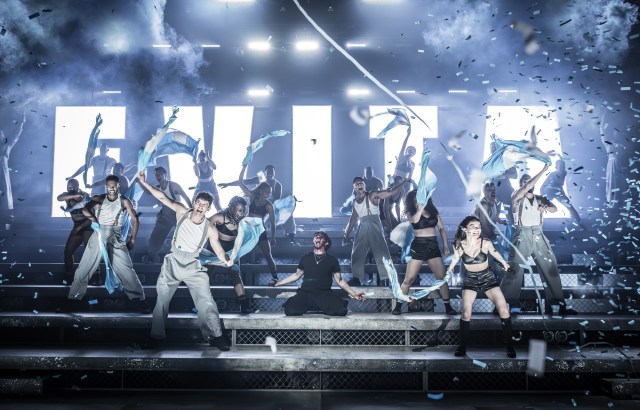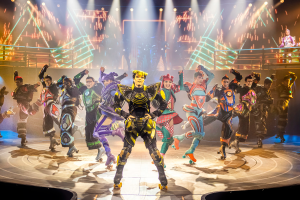Evita with Rachel Zegler review – high-flying, adored and awe-inspiring
Jamie Lloyd’s production continues at The London Palladium until 6 September

There has been more hype and excitement surrounding Jamie Lloyd’s Evita, starring West Side Story and Snow White heroine Rachel Zegler, than any other show in the West End’s recent history.
From the moment it was announced, speculation was rife. Then TikTok clips emerged of Zegler, in a blonde wig and pure white ballerina ball gown like a tiny doll, singing “Don’t Cry For Me Argentina” from the balcony of The London Palladium. Cue insanity, crowds gathering outside the theatre for her performance, and an earnest debate about whether the audience is getting what they have paid for.
The answer is quite simple: they are. Everyone is. This Evita might be regarded as the apotheosis of Lloyd’s mid-period style and Andrew Lloyd Webber and Tim Rice should be down on their knees thanking him for allowing their strongest, darkest show, first seen in 1978, to gleam with diamond-sharp brilliance.
Listen to our free podcast review of the show:
There was a dry run for this production at Regent’s Park Open Air Theatre in 2019, and the lineaments of that version are here. Soutra Gilmour’s set of stacked bleachers with the brilliant band (under the supervision and direction of Alan Williams) at the top, and her stylised costumes, still strip away all period settings; Jon Clark’s lighting sculpts and glistens, beginning bright, full of warm sun and rich purples and reds, but getting progressively darker as the story of Eva Perón, wife of the dictatorial president of Argentina, reaches its close.
Everything still feels essential and stark. But the difference here is that it is so much bigger and more dazzling – it fills the vast Palladium with the confidence of its storytelling as it charts Evita’s progress from struggling actress to radio star, to a saint-like figure, the “spiritual leader of her nation”, idolised by the poor people that she championed whilst suspected by her critics of personal greed and ambition.

Part of that is down to the effect of Zegler’s central performance. She really is superb, with a clear, strong voice and astonishing amounts of energy as she powers her way through the show. That famous balcony scene is much more than a gimmick. It marks the culmination of her hard-headed journey from nothing – seducing a tango dancer to get to Buenos Aires, telling ambitious politician Juan Perón that “I’d be surprisingly good for you”, organising elections, ridding herself of her opponents, with the help of a soldier figure in jodhpurs and bra-top; their deaths represented by balloons that explode with blue confetti. The end of the first act is a riot of ticker tape and streamers, raining from the roof onto the stalls.
Each song, each scene, becomes a staging post, soliloquies and commentaries on a life. Zegler, in tight black bustier and pants, is constantly on stage, joining in the routines, eyes flashing, watchful as a cat. Fabian Aliose’s outstanding choreography is all fierce lines and vigorous diagonals. Tango provides its pulse and its shapes. The movement, performed by some astonishing dancers, is full of detail – curved arms raised to heaven that frame the action, poses that create friezes, extended legs, passionate lifts.
When Zegler sings “Don’t Cry For Me Argentina”, it is the first scene that the production uses video. The camera tracks her slight figure as she progresses to the balcony, a human about to become a symbol. Then, when she is outside, it uses the gathered crowds as the “shirtless ones”, blending their images with Zegler’s face, making a metaphor of Evita’s power to move masses, to sway them to her will. She delivers the famous piece with great delicacy, smiling when she says, “I choose freedom”, letting the words land lightly.
It is remarkably effective. Lloyd’s quality as a director is that he generates huge momentum, but he also understands stillness and subtlety. He lets the acting breathe. “On This Night of A Thousand Stars” is full of action, but Zegler is given space to roll her eyes at the idiocy of the tango singer (Aaron Lee Lambert), who becomes “the first man to be used by Eva Perón”. When she displaces Juan Perón’s previous mistress, her look of triumph is undercut with a whiff of melancholy as Bella Brown sings “Another Suitcase, Another Hall”, vanishing into obscurity by donning a grey shift dress. Her mobile face, the range of her voice, her tiny inflections of head and body to convey thought and feeling all mark Zegler as a true star.
But she is matched by Diego Andres Rodriguez, making a remarkable West End debut as Che, commentating on the action with charisma and bite, turning a stock figure into a character, someone whose views are worth caring about. It’s a performance of heft but restraint; towards the close, as he lies splattered in paint at the front of the stage, the savage sadness he conveys makes Evita’s early death less sentimental.
Ultimately, like it or loathe it (which some people will), this Evita is an event with a capital E, an assertion of the unique power of theatre to become both story and spectacle, to draw people in. After watching from the auditorium, I returned the next night to see Zegler’s balcony scene from outside. A crowd, more than a thousand strong, waited patiently, a mixture of the committed, the curious and the frankly confused.
When she appeared, gliding along, everyone fell silent, hushing the noisy rickshaws zooming past on Oxford Street. The impact lands more quietly than inside the Palladium; there’s an almost magical sense of a small human voice soaring across the street. Zegler holds everyone in the palm of her hand, ignoring all distractions. “It shows why theatre matters, doesn’t it?” a woman told her sceptical husband at the end. “It’s something for all of us.”
Listen to our free podcast going behind-the-scenes on the show:



















